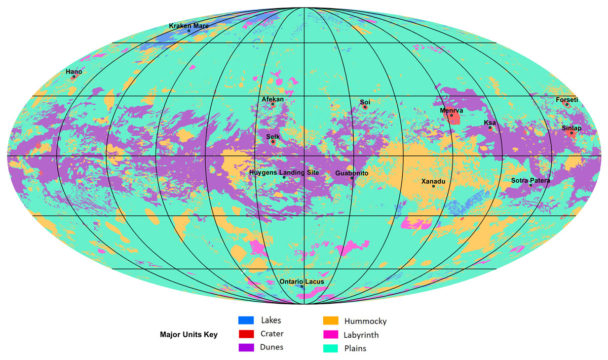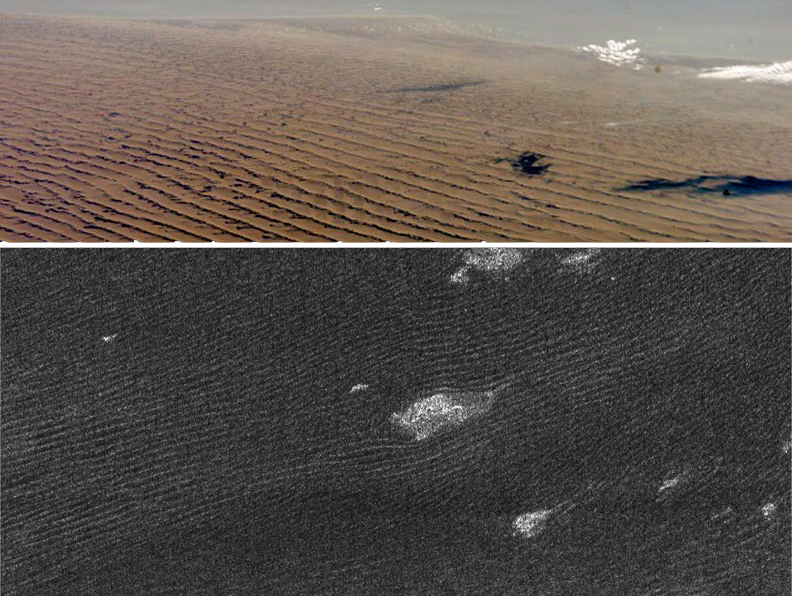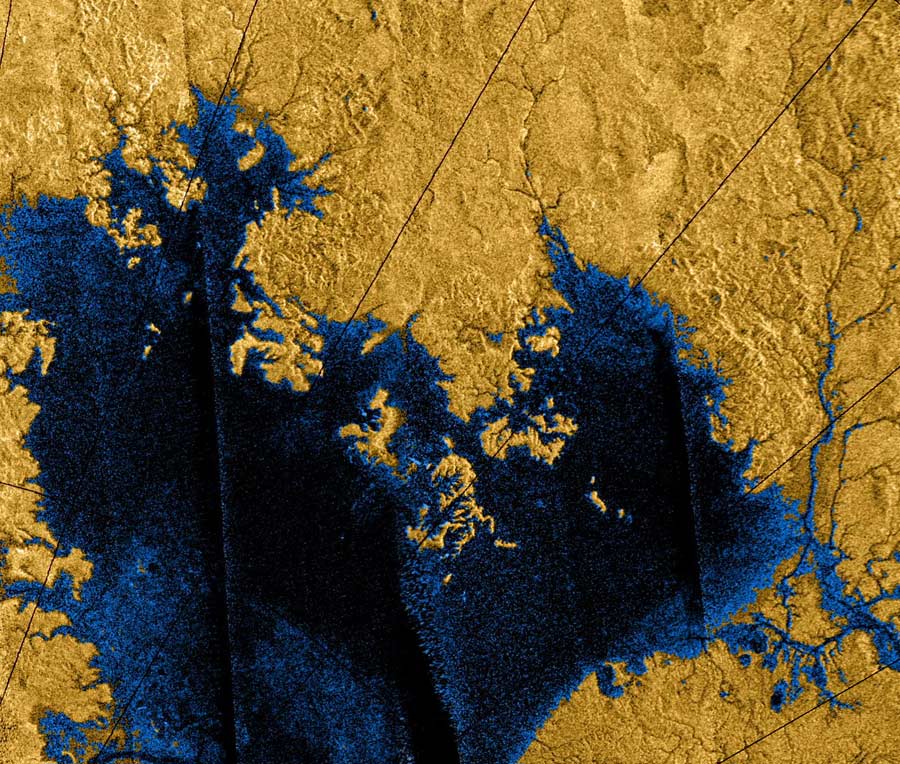Working with data from NASA’s Cassini mission, scientists have produced the first global map of Titan’s geological features.
Scientists have created a new map of Saturn’s moon Titan that shows its unique geological features and how they’ve evolved over time. The map is all the more fascinating because it shows that the same geological processes that work on Earth also work on Titan. Only on Titan, the temperature is so achingly cold (98 K, or -290°F) that any liquid carving its surface is not water but hydrocarbons, mainly methane and ethane.

NASA / JPL-Caltech / ASU
To create the global map, Rosaly Lopes (Caltech) and her colleagues combined data collected by NASA’s Cassini mission, which flew by the moon more than 120 times. In addition to high-resolution radar mapping that covered almost half of the moon’s surface, the spacecraft also characterized the surface using lower-resolution radar, infrared images, and infrared spectra.
High-resolution radar captured details as small as 1 kilometer (0.6 mile) across. The global map, on the other hand, has a scale of 1:20,000,000, which means that every centimeter on the map corresponds to 200 km on the moon’s surface. By filling in the full globe, even at lower resolution, the map not only charts the diverse geological formations on Titan, but it also enables planetary scientists to see how those features evolved over time.
In November 18th’s Nature Astronomy, Lopes and colleagues describe six main types of geological features — all of them eerily familiar to ones on Earth. Based on how the features overlap each other, the researchers are also able to tell their relative ages.
Dunes dominate Titan’s equatorial latitudes and take up about a fifth of the surface overall. Previous measurements have shown that these dunes are much like the ones that snake across deserts on Earth, except that the “sand” is made of solid hydrocarbons. They’re about 1–2 km wide, 1–4 km apart, and as tall as 80–130 meters, reaching or even surpassing the height of the Statue of Liberty. Dunes appear to be among the youngest features on Titan.

Upper image: NASA / JSC; Lower image: NASA / JPL
NASA’s Dragonfly mission, targeting a 2034 landing on the faraway moon, will land on and investigate the Shangri-La Dune.
Lakes, like dunes, are newer features on Titan that tend to cluster around the poles. Lakes may be dry or wet, but most of the wet ones are found around the north pole — global climate changes might be responsible for the dichotomy. Large lakes appear to have flooded in, while smaller lakes have steep sides that scientists still can’t explain — though one idea researchers have floated is that the smaller lakes are explosion craters, formed long ago when liquid molecular nitrogen deposits blew holes in Titan's crust.

NASA / JPL-Caltech / ASI / Cornell
Unfortunately, there’s no overlap between the polar lakes and the equatorial dunes, so there’s no way to see which of these is younger than the other. The separation of the two features reveals a global variation in climate, from the arid equator to the more humid poles.
Plains are featureless, flat regions that make up almost two-thirds (65%) of Titan’s surface. They appear dark in radar images, but spectra show that they tend to hold material swept in by the wind from nearby regions. For example, plains near the dunes tend to have some dune material on them, and plains near the labyrinths likewise show signatures of labyrinth material. The plains are intermediate in age.
Labyrinths are fascinating structures that appear to be like karstic terrain on Earth. They cover about 2% of Titan’s surface. Like Earth’s karsts, Titan’s labyrinths probably formed when rain (albeit, of the methane variety) dissolves rock, creating steep channels over time. The labyrinths are older than the dunes and lakes, but younger than Titan’s hummocks.
Craters make up less than 1% of Titan’s surface. Spectra show that the impacts have excavated some water ice. The ones that are there could be several hundred million years old, but various processes that erode Titan’s surface have washed away any older ones. The lake-filled poles, in particular, are almost craterless.
Regions designated as hummocky consist of rolling hills and mountains typically a few to tens of kilometers long and a couple kilometers high. These are among the oldest features on Titan. As with the craters, spectra of the hummocky regions reveal water-ice, supporting the idea that the irregular terrain, along with the excavated craters, could represent exposed remnants of an icy crust that’s dusted over with hydrocarbons.
The new map of Titan is not the first to portray these features, but it provides — for the first time — a global view, revealing patterns in their appearance on Saturn's largest moon.
 12
12









Comments
Micromonkey
November 18, 2019 at 7:51 pm
I want the Mercator projection that exaggerates the size of Ontario Lacus and Kraken Mare
You must be logged in to post a comment.
Monica YoungPost Author
November 18, 2019 at 9:17 pm
I agree! The map in the Nature Astronomy paper, if you have access, is a Mercator projection. It makes the difference between the geology of the equatorial region and the poles easier to see: https://www.nature.com/articles/s41550-019-0917-6
You must be logged in to post a comment.
Anthony Barreiro
November 19, 2019 at 5:37 pm
I like this equal-area projection map. It shows at a glance the proportions of different geological features on Titan's surface: mostly plains, a lot of dunes, some hummocks, and a smattering of other kinds of stuff. A Mercator projection would give the impression that the lakes cover a lot more area than they really do. Just like the Mercator projection map of the Earth makes Greenland look bigger than Africa.
P.S. The caption for the map erroneously states the image is a Cassini photo of Titan in front of Saturn's rings.
You must be logged in to post a comment.
Monica YoungPost Author
November 20, 2019 at 10:36 am
Keeping me honest, as always, Anthony! I've fixed the caption, which slipped in there when I loaded two images at once. I agree with you that the map in this post nicely portrays the areas covered. It's just that the contrast between equator and poles is less dramatic. The Nature Astronomy paper also has maps of the two polar regions, by the way, which are also interesting to compare!
You must be logged in to post a comment.
Anthony Barreiro
November 20, 2019 at 5:27 pm
Thanks! I don't want to spend $9 to read the Nature Astronomy article. Any chance of getting the Mercator and polar maps to publish on S&T?
You must be logged in to post a comment.
Monica YoungPost Author
November 21, 2019 at 1:02 pm
Unfortunately, there's a bit of a process (and $$, more than $9!) involved to obtain Nature graphics — understandably so, as they take time and effort to produce. Sorry I can't be of more help!
You must be logged in to post a comment.
Anthony Barreiro
November 21, 2019 at 6:02 pm
No problem. Thanks for the info.
You must be logged in to post a comment.
Ken-Winters
November 18, 2019 at 9:34 pm
There's one question I have (being hopelessly curious). Where on the map is Shangri-La Dune? No hurry though. Dragonfly isn't due there for more than 14 years.
As for lakes vs. dunes: Even if they overlapped, maybe with 'sand' getting blown into the lakes, that wouldn't tell us which initially formed first. Dunes and lakes both continue to change over time. I suspect that it will be very difficult to determine when lakes and dunes first formed on Titan, even after we have (well insulated) 'boots on the ground' on Titan. And to clarify, a 'Titan suit' would not be a space suit. It would have to be heated internally to keep a human alive, and very, very well insulated to keep the heat inside from destroying the surrounding 'country side'. Imagine a humanoid alien with a body temperature of 1000 degrees Celsius (1832 Fahrenheit) walking around on Earth. On Titan water ice is a rock and we are effectively made of molten lava. Yikes!
You must be logged in to post a comment.
Monica YoungPost Author
November 19, 2019 at 9:48 am
Wow, I love that analogy - I hadn't thought of it that way before!
To answer your question about the Dragonfly landing site, there's a map of Titan features here: https://commons.wikimedia.org/wiki/File:PIA20713-Titan-SaturnMoon-LabeledFeaturesIAU-June2015.jpg that shows Shangri-La as being the big dune region to the right of the Huygens landing site.
You must be logged in to post a comment.
Rich
November 25, 2019 at 2:49 pm
Here's the link to original NASA JPL page for PIA20713 (wiki link seems broken):
https://photojournal.jpl.nasa.gov/catalog/PIA20713
You must be logged in to post a comment.
Rich
November 25, 2019 at 2:53 pm
PS: wiki link said no image found when I clicked on link. I could right-click on the wiki link, save the link location & then past the URL in my browser.
You must be logged in to post a comment.
Anthony Barreiro
November 19, 2019 at 5:46 pm
Just send robots. The romantic obsession with sending humans beyond the Earth blinds us to the vast superiority of robotic space exploration. While we waste time, money, and brainpower trying to figure out how to send a few humans to Mars without dissolving their bones in microgravity, frying their DNA with ionizing radiation, and driving them crazy in the isolated confined environment of a spacecraft, we could be investing our resources into sending hundreds of thousands of purpose-built robots to every corner of our solar system, and to nearby stars.
You must be logged in to post a comment.
You must be logged in to post a comment.